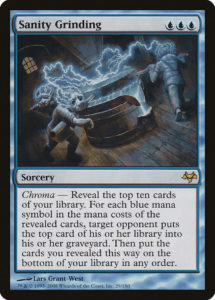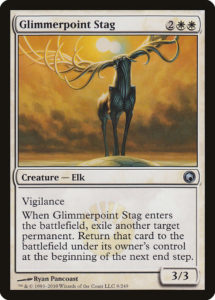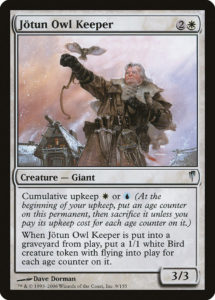Mechanics come and go. Most show up once in Standard, perhaps to be seen again in less restrictive sets like Commander, Battlebond, and Modern Horizons. Many of the best return repeatedly (like Cycling and Kicker) or irregularly (like Morph, Exalted, and Convoke); but it’s rare to see less popular mechanics like Chroma be rehabilitated (into Devotion) or wonkier mechanics like Madness return to Standard. Core 2021 manages to do both, bringing back one of Magic’s least popular, oldest, and wonkiest mechanics: Phasing.
I’d be shocked if Phasing were on anyone’s bingo list for 2020, much less in a Core Set. The mechanic is not beloved. It’s complicated, it’s weak, and it’s only shown up on two cards since 1997—Teferi’s Protection and Old Fogey. And yet with Teferi in the Gatewatch and the focus of Core 2021, his associated mechanic Phasing is back. Well, the best part of it is.
Leave Out the Worst
We don’t yet know what will be printed in Core 2021. Currently, only a single revealed card references Phasing: the mythic rare Teferi, Master of Time. As with Teferi’s Protection, this new Teferi eschews the awkwardness of Phasing and just Phases things out instead. This is probably for the best, since Phasing itself was not fun. It was a downside mechanic that took your creature away every other turn (and discounted it by about one mana). Phasing came from a different time, when downside mechanics like Echo, Cumulative Upkeep, and Snow (which was more often punitive than beneficial in Ice Age) were somehow all the rage.
However, Phasing allowed for more than merely discounting creatures. Even when introduced in Mirage, it was used to Phase things out. It served as temporary disruption (Dream Fighter), protection (Mist Dragon), additional downside (Taniwha), and a nifty tweak on looting (Teferi’s Imp). This utility is what we’re seeing return with Teferi, Master of Time: phasing as temporary disruption or protection. These uses are akin to flickering (exiling a creature then immediately bringing it back) and tapping, though it’s closest in effect to blinking (exiling a creature and bringing it back at end of turn).
Blinking’s not Just a Phase
Blinking is ancient technology in Magic, almost as old as Phasing. Flickering was introduced with 1999’s Flicker and blinking followed shortly thereafter with 2000’s Liberate. Both mechanics got a boost in comprehensibility in 2009 when M10 introduced the exile zone.
One wonders why Magic would bring Phasing back at all when flickering has so consistently done solid work. The differences between the two are fairly subtle; and while players have had a decade to familiarize themselves with the exile zone, Phasing has no such named holding zone and brings all sorts of rules complications (like it’s the only thing that happens on your Untap Step besides untapping your creatures).
Of course, Phasing has advantages over temporary exiling. It’s likely more intuitive for a creature to phase back in exactly as it was before rather than return from exile without its attachments and with summoning sickness. Exiling’s years of being the standard has led to undesirable underminers like Wasteland Strangler and Riftsweeper, while Phasing has little to fear aside from Spatial Binding, Time and Tide, Sands of Time, and Statis. Blinking and flickering have proven dangerous on creatures like Felidar Guardian and Yorion, Sky Nomad, but Phasing doesn’t retrigger ETB effects to enable combos.
Phasing has weird rules nuances like not being bothered by Containment Priest, which is also in Core 2021, but “ignore this creature” until you untap is pretty straightforward. Magic has learned that newer players can deal with complexity when it feels exciting and makes sense—metrics which Phasing presumably meets if it’s appearing in Core 2021. If this experiment goes well, there’s even a chance that Magic could supplant some exiling effects with phasing. Or perhaps there’s even more phasing cards we haven’t seen yet and it’s not merely on Teferi, Master of Time and Teferi, Timeless Voyager.
Regrowing Seeds of the Past
The biggest takeaway from Phasing’s return lies there: recognizing the value hidden within discarded, weaker, and less popular designs. It’s exceedingly rare to see a mechanic fully rehabilitated, as Chroma was into Devotion. But there are plenty of individual cards that spun into entire mechanics long after being forgotten—like Elkin Bottle, Goblin War Drums, and Renegade Warlord. Sometimes you can pick and choose the best part of a mechanic, as with Phasing today.
What else is lying in the past, waiting to be brought back? Cumulative Upkeep is less fun because it provides your creatures with a finite (and expensive) tenure in your service, but Mind Unbound turned the concept into all upside (with some risk). Banding is ludicrously complicated and overpowered defensively, but the concept of creatures teaming is something we see revisited time and again, as with Battalion, Mentor, Convoke, and even Soulbond.
As game designers, the past is one of the most valuable resources. Not only do we use our experiences to know what mechanics and designs work best, but we can reuse discarded ideas in different contexts where they function better. Critically, we can remind ourselves that an idea discarded today is an idea we can use tomorrow—a real boon when you’re cutting 90% or more of your designs over the course of a project. While I want to see what they do with it and how its execution plays out, it’s lovely seeing Magic bring back an old, written-off experiment. Phasing reminds us that the past is always there for us, often hiding the future in plain sight if only we care to reflect on our history.
And, as always, thanks for reading.
—Zachary Barash is a New York City-based game designer and the commissioner of Team Draft League. He designs for Kingdom Death: Monster, has a Game Design MFA from the NYU Game Center, and does freelance gatame design. When the stars align, he streams Magic (but the stars align way less often than he’d like).




